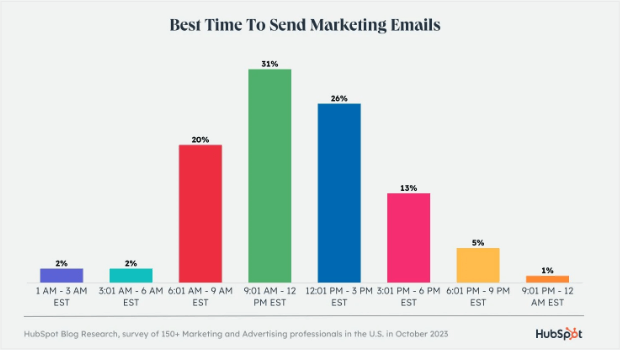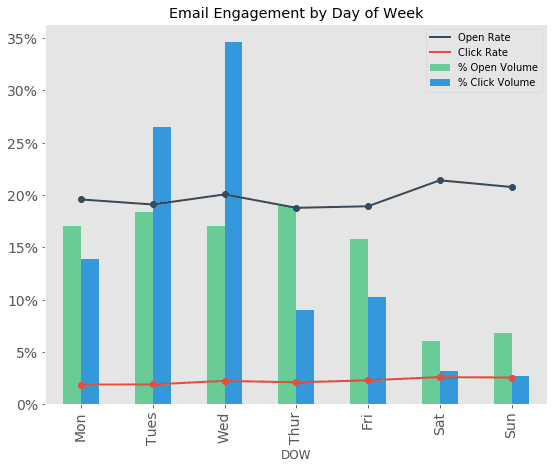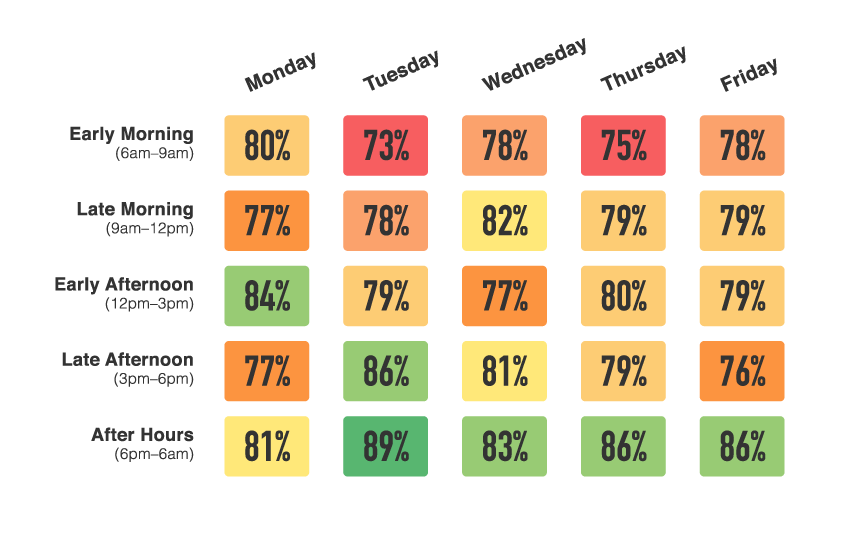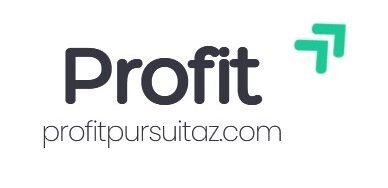Best Time of Day for Email Marketing: Maximize Engagement
Timing is crucial in email marketing. It can influence open rates and engagement.
Finding the best time of day to send emails can boost your campaign’s success. But when is this ideal time? Many factors affect it, like your audience’s habits and time zones. Understanding these can help you reach your audience more effectively.
Email marketing is a powerful tool. It connects businesses with customers directly. Yet, the time you send an email can change its impact. Sending at the wrong time might mean your message gets lost. But the right timing can grab attention. It can increase the chances of your email being read and acted upon. The goal is to understand when your audience is most active. This way, your emails land in their inbox when they’re ready to engage.

Credit: optinmonster.com
Importance Of Timing
Email marketing success relies heavily on timing. The right moment can boost engagement. Sending emails at the wrong time can hurt your results. Timing affects open and click-through rates. Understanding this helps optimize campaigns. Knowing your audience’s habits is key. This can enhance your marketing strategy.
Impact On Open Rates
Open rates measure how many people open your emails. Timing plays a big role here. People check their emails at specific times. Mornings are usually active for email checking. Sending emails early increases chances of opening. Late-night emails might be ignored. Testing different times can reveal the best window.
Influence On Click-through Rates
Click-through rates show how many clicked your links. Timing impacts this metric too. Emails sent during work breaks might see higher clicks. Lunch breaks and evenings can be optimal. Knowing when your audience is free helps. They are more likely to engage during these times. Experimenting with times can improve clicks.
Morning Email Strategy
Sending emails in the morning can boost engagement rates. Many people check their emails early in the day. It’s the perfect time to catch their attention with your message.
The timing of your email sends can greatly influence your marketing success. If you aim to boost engagement, consider adopting a morning email strategy. Sending emails in the morning can be a game-changer, especially when you understand the nuances of why and how it works.
Benefits Of Morning Sends
Sending emails in the morning can result in higher open rates. People often check their inboxes first thing after waking up, making your email one of the first they see. This can lead to increased attention and a better chance of your message being read.
Morning emails can also set a productive tone for the day. When your email offers valuable insights or solutions, recipients might use this information to plan their day. It’s an excellent opportunity for your brand to become part of their routine.
Moreover, sending emails in the morning can help you avoid the afternoon slump. By reaching your audience early, you avoid the risk of your email getting buried under other messages received later in the day.
Target Audience For Mornings
Morning emails work exceptionally well for professionals who start their workdays early. This group often checks emails over breakfast or during their morning commute. If your target audience includes busy professionals, morning emails can be particularly effective.
Parents who rise early to prepare for their family’s day are another key audience. They’re likely to check emails during their morning routine, so reaching them during this window can be advantageous.
Consider early risers who enjoy starting their day with fresh information. They might be health enthusiasts or those who prefer to plan their day in advance. Tailoring your content to appeal to these groups can boost your engagement.
Have you ever noticed how your own email-checking habits vary throughout the day? Understanding your audience’s routines can offer valuable insights into optimizing your email strategy. What small changes can you make today to capture your audience’s attention in the morning?
Midday Email Strategy
Timing is crucial in email marketing. Sending emails at the right time can greatly impact engagement rates. Many marketers opt for a midday email strategy. Sending emails during this time aligns with typical workday patterns. People often check emails during lunch breaks. This can lead to higher open and click rates. Midday sends can capture attention before afternoon meetings. Let’s explore the midday email strategy further.
Advantages Of Midday Sends
Midday sends can reach people at their peak attention levels. Many are taking breaks or catching up on emails. This time slot offers less competition from other emails. It also allows recipients to focus on content without rush. Messages sent at noon can stand out in crowded inboxes. The midday window can maximize visibility and engagement.
Engagement Trends At Noon
Statistics show increased email engagement around noon. People are active online and ready to interact. Open rates often peak during this time. Click-through rates can also rise. Noon sends can lead to higher conversion rates. Timing your emails for this period can boost performance. Recipients are more likely to respond to midday emails.

Credit: optinmonster.com
Afternoon Email Strategy
Crafting an effective afternoon email strategy can boost engagement. Many people check emails during their lunch break. They also catch up on messages before the day ends. Sending emails in the afternoon can capture this attention. It can lead to higher open and click rates. Let’s explore why this time works well and the best content to include.
Why Afternoon Works
Afternoons are a time when people are alert. Their morning tasks are usually complete. They’re more likely to read emails with focus. The inbox is less crowded than in the morning. This means your email stands out. People often have more energy. They’re ready to explore and engage with content. This makes the afternoon a prime time for your messages.
Best Content For Afternoons
Afternoon emails should be engaging and valuable. Include tips, insights, or updates that interest your audience. Short, concise messages work best. People appreciate quick reads during a busy day. Consider including a call to action. This could be a link to a blog post or a special offer. Ensure content is relevant and timely. This increases the chance of interaction.
Evening Email Strategy
Email marketing can be a powerful tool, but timing is everything. The evening offers unique opportunities for engagement. With people winding down from their day, they might be more open to checking emails. This is when you can catch their attention, just as they relax with a warm cup of tea or unwind with their favorite show.
Evening Engagement Patterns
People’s routines shift in the evening. They tend to check emails between 8 PM and 10 PM. This is the time when many are done with work and daily tasks. They’re often browsing their phones or laptops, looking for entertainment or catching up on personal matters.
During these hours, people are likely more receptive to engaging content. Have you ever scrolled through your inbox after dinner? You’re not alone. Many people do the same, which is why sending emails during this window can be effective.
Consider the content you share. Evening emails might include deals on leisure activities or articles that help your audience relax and unwind. You want your email to be the one they click on amid their evening browsing.
Who To Target In The Evening
Think about your audience. Are they professionals who might be enjoying some downtime? Maybe they’re parents finally getting a moment of peace after the kids are asleep. Understand their evening habits and tailor your strategy accordingly.
For professionals, emails offering productivity tips for the next day can be appealing. Parents might appreciate content related to family activities or personal relaxation. Tailoring your message to fit their lifestyle can make your email stand out.
Consider segmenting your email list. This allows you to target specific groups effectively. Have you ever received an email that felt like it was speaking directly to you? That’s the goal. Make your evening emails resonate personally with your audience.
Engagement isn’t just about timing. It’s about understanding what your audience needs at that specific moment. Are you ready to make your evening email strategy more impactful?
Weekend Email Considerations
Have you ever wondered about the effectiveness of sending emails over the weekend? Weekend email considerations are crucial for marketers. It’s a time when your audience might be more relaxed and open to engaging with content. But how does this affect your email strategy? Let’s explore some key aspects.
Pros And Cons Of Weekend Sends
Sending emails over the weekend can have its advantages. People often have more free time, making them more likely to read your email. Think about your own weekend routines; you might be lounging with a coffee, casually checking your inbox.
However, there are downsides too. Weekends can be busy with personal activities. Emails might get ignored or buried under personal conversations. Consider if your content can compete for attention during leisure time.
So, weigh these pros and cons before scheduling your next weekend email. Is your message engaging enough to stand out?
Audience Preferences On Weekends
Your audience might prefer different email timings depending on their lifestyle. Are they early risers or do they prefer reading emails in the evening? A friend once told me she checks her emails while sipping her Saturday morning coffee. Maybe your audience does the same.
Use analytics to determine when your audience is most active over the weekend. Have you considered segmenting your audience based on their weekend preferences? Tailoring your send times can significantly improve engagement.
Understanding these preferences can give you a competitive edge. What insights can you gather from your audience’s weekend habits?
Weekend email considerations are not just about timing. They are about understanding your audience’s habits and adjusting your strategy accordingly. Will you take the leap and test weekend sends?
Industry-specific Timing
Timing is everything in email marketing, especially when it comes to industry-specific needs. You might wonder why the same email sent at different times can yield completely different results. Understanding the unique timing requirements of your industry can boost your email marketing strategy significantly. Let’s dive into how timing varies between industries like retail and B2B.
Retail Vs. B2b
Retail and B2B email marketing have different timing dynamics. Have you ever noticed that retail emails often flood your inbox during evenings or weekends? This is because these are prime times when consumers are relaxed and more likely to shop online. Retailers capitalize on leisure hours to engage with their audience.
In contrast, B2B emails typically hit inboxes during weekdays, especially mid-morning or early afternoon. These are the times when professionals are at their desks and more focused. B2B marketers aim to reach decision-makers when they are in work mode, ensuring their emails get the attention they deserve.
Differences In Timing Needs
Why do these differences matter? The effectiveness of your email campaigns hinges on understanding your audience’s daily routine. If you’re in retail, do you notice higher open rates during evenings? Adjust your schedule to send emails when your audience is most likely to engage.
B2B marketers, are your emails getting lost in the morning rush? Consider sending your messages after the initial burst of morning emails has been dealt with. This strategic timing could help your email stand out and get noticed.
Have you ever tested different timings for your campaigns? Experimentation can provide valuable insights into when your audience is most responsive. This data-driven approach allows you to fine-tune your strategy for maximum impact.
Would adjusting your email timing make a difference in engagement rates? The answer often lies in understanding industry-specific timing needs. Tailoring your strategy to suit these differences can be the key to unlocking higher conversion rates.
Testing And Analysis
Determining the optimal time for email marketing involves testing and analysis. Early mornings often yield high open rates, capturing attention before busy schedules. Midweek afternoons can also be effective, as recipients are more likely to engage with content during work breaks.
When it comes to email marketing, timing can be everything. Testing and analysis play a crucial role in determining the best time of day to send out emails. By understanding your audience’s habits and preferences, you can ensure your messages hit their inbox at just the right moment. This involves a mix of A/B testing and analyzing engagement data to fine-tune your strategy. Get ready to unlock the secrets of optimal email timing!
A/b Testing For Best Time
A/B testing allows you to experiment with different send times to see which yields the highest engagement. Start by selecting two different times to send your emails. For example, try sending one batch in the morning and another in the afternoon.
Track which time slot results in more opens and clicks.
You might be surprised; what works for one audience may not work for another. Consistently test new times as your audience’s habits might change over time.
Your aim is to find patterns that align with your specific audience’s behavior.
Analyzing Engagement Data
Dive into your email analytics to uncover insights about your audience’s engagement. Look at open rates, click-through rates, and conversion metrics to understand when your emails perform best.
Create a table or chart to visualize these patterns over time.
Ask yourself: Are there specific days or times when engagement peaks?
Use these insights to inform your future email scheduling decisions.
Remember, your audience might have unique preferences, so what works for a general audience might not apply to yours. Keep analyzing and adjusting to maintain optimal performance.
By testing and analyzing, you continually refine your approach, ensuring your emails are timely and effective.

Credit: staffbase.com
Frequently Asked Questions
What Is The Best Time Of Day To Send Marketing Emails?
The optimal time to send marketing emails is typically between 9 AM and 11 AM on weekdays. Early afternoon, around 1 PM to 3 PM, also works well. Testing different times can help identify what resonates best with your audience.
Is It Better To Send An Email At Night Or In The Morning?
Sending emails in the morning is generally better. Recipients are more likely to check their inbox and engage. Early morning emails often have higher open rates, increasing the chances of your message being read. Nighttime emails risk getting buried among others.
Aim for delivery between 9 AM and 11 AM.
What Is The Best Day To Send Internal Emails?
Tuesday is the best day to send internal emails. Employees are more focused after catching up on Monday. This day ensures better engagement and response rates, maximizing productivity and communication. Sending emails mid-morning targets peak attention levels, helping your message stand out and be prioritized.
What Is The Best Day To Send Cold Emails?
Tuesday and Thursday are the best days to send cold emails. These days typically have higher open rates. Aim to send emails mid-morning for optimal results. Keep your content engaging and concise to capture attention.
Conclusion
Choosing the right time for email marketing can boost engagement. Test different times to find what works best for your audience. Morning emails might catch early risers, while afternoon emails can reach busy professionals. Evening sends could appeal to those relaxing after work.
Analyze your data to refine your strategy. Consistency is key. Keep tracking results and adjusting as needed. Understand your audience’s habits. Maximize your email’s impact with timing that suits them. Thoughtful timing enhances communication. Make every send count. Each email is an opportunity to connect.
Prioritize timing for better results.
